List of Authors
>>About this blog
Recent blog post
|
[Nojinya]
June 27, 2014 09:00
How are your blog readers going to spend during the rainy season? If you think that there was a sunny day like midsummer in this year's rainy season, it's abnormal weather such as hail and sudden thunderstorm!
Unlike the perfect season for going out in early spring, you are worried about sudden changes in the weather these days. Today, I would like to change my taste a little more than usual, and explore Chuo-ku in literature and Ishikawajima and Tsukuda in the Edo period.
On the way back from the company on Friday, I bought two books set in Chuo-ku at a bookstore in front of Tokyo Station. set in Chuo-ku at a bookstore in front of Tokyo Station.
Speaking of period literature in Chuo-ku, first of all, Shotaro Ikenami's "Kihei Crime Book". This is a TV drama and novel that is famous as a model by Heizo Hasegawa, who managed the Ishikawajima Ashoshoshojo under Sadanobu Matsudaira in the latter half of the 18th century in Edo's mid-18th century. I would like to introduce a novel focusing on a people-shore by changing the angle a little.
The first book is Seicho Matsumoto's "Mujukujin Separate Book" (Bunshun Bunko). This short story book contains 10 stories, of which  "Tsunami" is a story of a human footing. In the novel, Shinta, who was born in a fisherman in Noto and drifted to Edo and was stopped by Okabiki while walking around the town, was taken to Tsujibansho, and was taken to a temporary prison in Temmacho. Will be put in From Temmacho, they are sent to Kanayama in Sado, where they are forced to work on watering a tunnel like hell, and often lose their lives, but Shinta is fortunately sent to Ishikawajima. "Tsunami" is a story of a human footing. In the novel, Shinta, who was born in a fisherman in Noto and drifted to Edo and was stopped by Okabiki while walking around the town, was taken to Tsujibansho, and was taken to a temporary prison in Temmacho. Will be put in From Temmacho, they are sent to Kanayama in Sado, where they are forced to work on watering a tunnel like hell, and often lose their lives, but Shinta is fortunately sent to Ishikawajima.
According to a textbook on Japanese history, `` As the number of non-stayers who abandoned rural areas and flowed into Edo due to the famine in the Tenmei era in the latter half of the 18th century increased, the Shogunate accommodated these non-stayers in Ishikawajima's people's horoscopes to improve security. ", And from such an explanation, it seems to be a little more calm thing like a prison. "Tsunami" also states that "things with good results after a certain period of time will be given labor wages and released", and they do not impose extreme labor, but carpenters, plasterers, blacksmiths, etc. It seems that Ishikawajima was given a job related to them for those who have a job in hand with a farmer, such as a farmer, etc.
One autumn day, a fisherman sees the clouds and predicts that the tsunami will come. Ishikawajima, Tsukudajima, and Tsukiji were quickly attacked by the tsunami, and with the permission of Yoba magistrate, `` escape, and if the high waves subside, gather near Eitai Bridge '' and swim while diving in the waves to Fukagawa. . The novel doesn't tell you if Shinta finally returned to Eitai Bridge, but this novel allows us to learn about the crowds at that time.
Furthermore, in the nine other stories of the Unjukujin Book, the story of the prison in Temmacho, the island flow to Hachijojima Island, and the escape from Sadogashima in 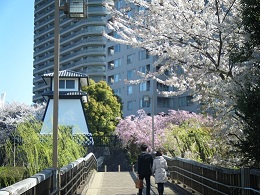 the world's hell, you can learn about various worlds in relatively different places from relatively humanitarian places such as "Ishikawajima Hitoshishoroba". the world's hell, you can learn about various worlds in relatively different places from relatively humanitarian places such as "Ishikawajima Hitoshishoroba".
It's a good idea to go back in time to Edo through novels during the rainy season.
Next time, I would like to introduce Shugoro Yamamoto's "Sabu", which I bought at another bookstore.
(The upper right photo shows the Ishikawajima Lighthouse, which was introduced in the blog on April 7 of the cherry blossom season, "Ohanami Walk from Shinkawa Park to Chuo-ohashi Bridge and Tsukuda Park": /archive/2014/04/post-1956.html)
[Taro Edo]
June 24, 2014 18:00
Walking around the city of Ginza, I was walking around.
On the wall of the construction site in Ginza Matsuzakaya
The scenery of Ginza was introduced in Nishiki-e.
Here's one of them.
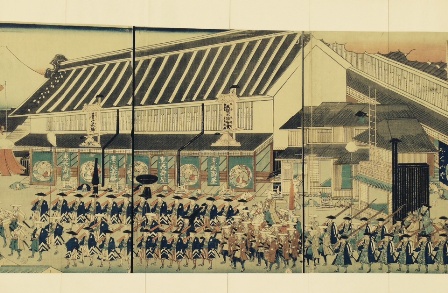
A map of Edo famous Obari-cho
Yoshimune Utagawa painting
1863 (Bunkyu 3)
It depicts the appearance of the 14th Shogun Shigeru, who passes in front of a kimono shop in Owaricho.
Owaricho is around the current Ginza 5-6 chome.
Exhibit :Chuo Ward Local Tenmonkan (Time Dome Akashi)
[Silver]
June 20, 2014 14:00
Everyone, do you know why there are no skyscrapers in Ginza?
"It's because the ward office regulates height restrictions," and "Yes, there is a" Ginza rule "."
I didn't have any questions about it about 10 years ago.
I like Ginza, and I like walking not only on Ginza Street, but also on Namiki-dori St. and Marronnier Street, but I didn't think, "Why do you like walking around Ginza?"
It's not just because the sidewalks are well maintained. Eye-friendly space, calm building colors, stylish jackets in windows, etc.
And a pedestrian paradise on Ginza Street. People don't walk in a hurry.
This overlapped, and I felt that I could relax and enjoy the silver bra, so I could think.
Recently, I became interested in pursuing "why there are no skyscrapers in Ginza ?" At that time, I found this book at the Kyobunkan. ?" At that time, I found this book at the Kyobunkan.
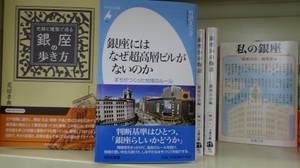
The author is Eriko Takezawa, Secretary-General of the Ginza City Planning Council and Ginza Design Council.
This person's lecture had been heard at "Ginza Gaku" at Tsukiji Social Education Center and at the "Environmental Community Development Forum" at the Paper and Pulp Hall.
However, it was not possible to deepen the understanding of the "Ginza Filter" and "Ginza Rules" within a limited time.
After that, I passed the residential land and building transaction manager test, gained new knowledge such as restrictions on development such as district planning, and gained a different interest, and learned about this book.
The composition of this book is as follows.
Chapter 1 What kind of city is Ginza?
Chapter 2 The eve of large-scale development, Ginza in the 1990s
Formulation of the first district plan "Ginza Rules"
Chapter 3 A skyscraper of 200 meters is in Ginza?
"Ginza Town Planning Conference" started in 2004.
Chapter 4 The Voice of Ginza to Government
Chapter 5 New Architecture requires prior consultation with Ginza
Start of the Ginza Design Council
Epilogue
Sweeping
(Impressions and recommendations after reading)
Ginza's history, it is based on the spatial size created by the relationship between the land and buildings of Edo townspeople.
I realize that the cityscape of Ginza has been cherished as a property, so it is fun to walk around Ginza.
In this book, the word "sharing" appears many times. For large-scale development, awareness of the current situation of residents and shop owners, sharing visions for the future, and sharing values.
Regarding the plan to increase the floor of Ginza Mitsukoshi, the question  of why the installation of an aerial corridor was made clear. of why the installation of an aerial corridor was made clear.
Regarding the plan to rebuild Kabukiza, we also knew why we were able to clear the conventional height limit . .
And the Ginza 6-chome plan is also described in detail.
What the author thought was great and great was not only a wealth of vocabulary, but also a solid description of sentences using adjectives and adverbs. I was amazed that this was the sentence of "Ginza-likeness".
And if he thought he had a great deal of knowledge about the Building Standards Law and urban planning, he said that he had passed through the gates of the university and studied again about what he had been involved in. I really admire you.
We recommend that you subscribe not only to those who live and work in Chuo-ku, but also to architecture, home construction, designers, and people of various genres.
Silver
[Akira Makibuchi / Sharakusai]
June 19, 2014 14:00
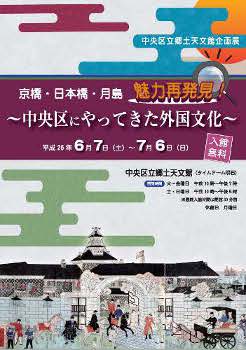 A special exhibition at Chuo-ku Folk Tenmonkan (Time Dome Akashi) "Rediscover the charm of Kyobashi, Nihonbashi, Tsukishima!" -Foreign culture that came to Chuo-ku-" is being held at the Kumin Gallery. Admission is free until July 6. For more information:>> A special exhibition at Chuo-ku Folk Tenmonkan (Time Dome Akashi) "Rediscover the charm of Kyobashi, Nihonbashi, Tsukishima!" -Foreign culture that came to Chuo-ku-" is being held at the Kumin Gallery. Admission is free until July 6. For more information:>>
During the Edo period, the Korean correspondent and Dutch trading post chief Edo Sanfu, the opening of foreign settlements in the Meiji period, and the expo plan, which became a phantom before the war, paintings and photographic panels depicting connections with foreign countries in the history of Chuo-ku.
Photographs taken from balloons launched at the Tsukiji Naval Training Center in 1904 (1904) are attracting attention. The view from above an altitude of about 200m is the "Tokyo Panorama Photographs" taken from Shinagawa to Hamarikyu, Imperial Palace, Ginza, and Nihonbashi. From the bird's-eye view of the sepia color, the streets of the past are revived. @ Akira Makibuchi
[Akira Makibuchi / Sharakusai]
June 18, 2014 09:00
The Sanno Festival at Hie-jinja Shrine is one of the three major festivals in Japan (Gion Festival, Tenjin Festival) and the three major festivals in Edo (Kanda festival and Fukagawa Hachiman Festival). It is known as the Tenka Festival during the Edo period, and is now held every other year with Kanda festival, but this year Hie-jinja Shrine corresponds to Reitaisai festival.
On the 13th, the Shinto Festival was a parade of about 300 meters along the route of Yaesu, Hatchobori, Kayabacho, Kabuto-cho, auxiliary shrine (resting place of portable shrines), Nihonbashi, Kyobashi and Ginza in the center of Chuo-ku. (Lower photo: Horai and zodiac floats walking around Nihonbashi 3-chome intersection on Chuo-dori)
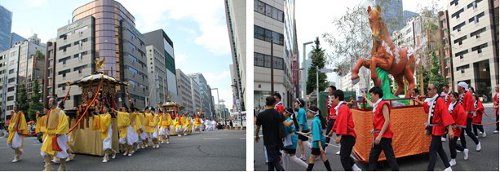
On the 15th, the Shitamachi Association carrying of miniature shrines was held, and 12 portable shrine floats in the town of shrine parishioner went out to Chuo-dori from Kyobashi Kitazume to Nihonbashi Minamizume. portable shrine paid a courtesy call to Nihonbashi Takashimaya (see from the 3rd floor of Nihonbashi Maruzen)
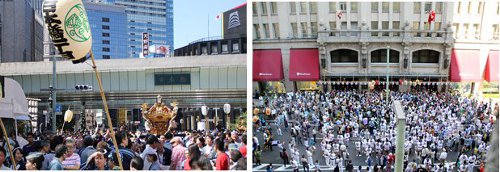
@Akira Makibuchi
1.
June 17, 2014 09:00
Have you seen the "New Play" recently? I haven't seen it for ten years now. Even though young people say "new drama", it has become commonplace to get them to know only when they say "the name of the theater company" and the affiliation of the actor on TV. . Tsukiji Small Theater, which has become the "source of all post-war new dramas" such as "Literature Theater", "Actor Theater", and "Meigaku", which are still active, opened on June 13, 90 years ago.
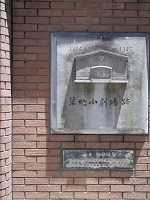 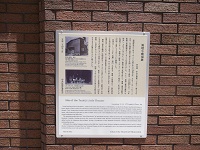
Now, a lecture entitled "Thinking about Modern Theater from the 90th anniversary of the founding of Tsukiji Small Theater" is being held at Chuo Kumin College. The coincidence that the second day is just the opening date of 90 years ago. As you all know, Kaoru Osanai, who was already well-known, opened with the aim of becoming a `` permanent hall for theater laboratory theater drama, a playhouse for the people '' as being involved in the heat of young Yoshi Hijikata . The first performance is three works: "Swan Song" (Chehof), "Sea Battle" (galing), and "Crest Day" (Mazoo). You can see the names of Akiko Tamura and Korenari Senda in the program. Directed by Kaoru Osanai and Yoshi Hijikata. It became a base for new theater activities as an experimental site for modern theater, but three months after Kaoru Osanai died suddenly in December 1928, the Tsukiji Small Theater splits. The activities of the Tsukiji Small Theater ended in just five years, and after that, the buildings of the theater were burned down at the end of the war in 1945. However, it goes without saying that the Tsukiji Small Theater had produced many human resources who were active in the theater world, became the roots of the existing theater company, and "all sources of post-war new drama" was located at this Tsukiji Small Theater. Professor Kodama of Waseda also mentioned, but the characteristic of Japanese theater is that "genre accumulates-layering". When a new theater is born, the previous theater does not disappear, but each one continues to live-a rare phenomenon in the world. This is why we can now enjoy theaters of various genres. Is this why we can't "dispose"? After a long absence, I came to see the "Monument of Tsukiji Small Theater Ruins" and thought about something stupid. Why don't you think about the theater people who founded a passionate passion for the 90th anniversary and dedicated it to theater activities?
"Monument of Tsukiji Small Theater Ruins" 2-11-17 Tsukiji Building Wall of NTT DATA Tsukiji Building
|
Links
|
![]() set in Chuo-ku at a bookstore in front of Tokyo Station.
set in Chuo-ku at a bookstore in front of Tokyo Station. "Tsunami" is a story of a human footing. In the novel, Shinta, who was born in a fisherman in Noto and drifted to Edo and was stopped by Okabiki while walking around the town, was taken to Tsujibansho, and was taken to a temporary prison in Temmacho. Will be put in From Temmacho, they are sent to Kanayama in Sado, where they are forced to work on watering a tunnel like hell, and often lose their lives, but Shinta is fortunately sent to Ishikawajima.
"Tsunami" is a story of a human footing. In the novel, Shinta, who was born in a fisherman in Noto and drifted to Edo and was stopped by Okabiki while walking around the town, was taken to Tsujibansho, and was taken to a temporary prison in Temmacho. Will be put in From Temmacho, they are sent to Kanayama in Sado, where they are forced to work on watering a tunnel like hell, and often lose their lives, but Shinta is fortunately sent to Ishikawajima.the world's hell, you can learn about various worlds in relatively different places from relatively humanitarian places such as "Ishikawajima Hitoshishoroba".


 A special exhibition at Chuo-ku Folk Tenmonkan (Time Dome Akashi) "Rediscover the charm of Kyobashi, Nihonbashi, Tsukishima!" -Foreign culture that came to Chuo-ku-" is being held at the Kumin Gallery. Admission is free until July 6. For more info
A special exhibition at Chuo-ku Folk Tenmonkan (Time Dome Akashi) "Rediscover the charm of Kyobashi, Nihonbashi, Tsukishima!" -Foreign culture that came to Chuo-ku-" is being held at the Kumin Gallery. Admission is free until July 6. For more info



